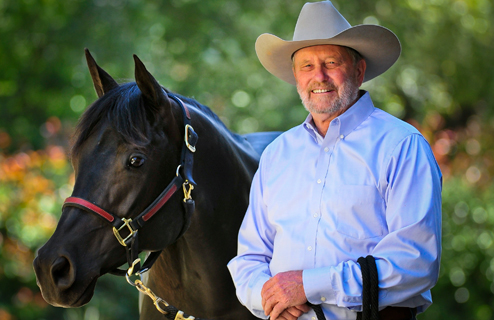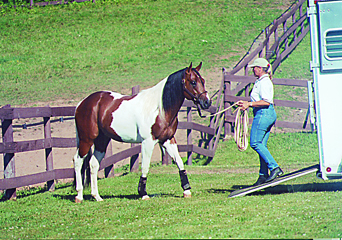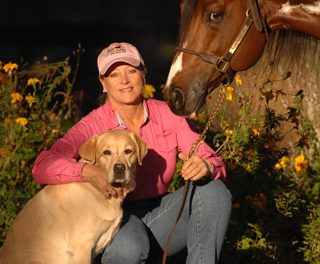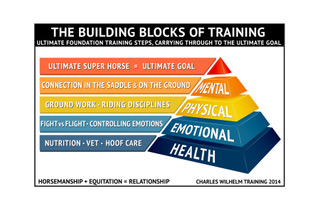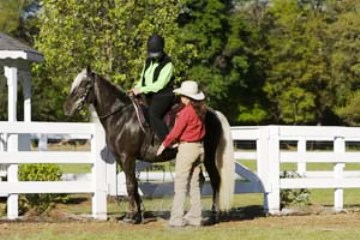After spending a good deal of time in the last few years working with beginning and returning riders, I find that working horses on the ground and riding horses is really a mental game. What I mean is that we may know how to ride correctly or we have been taught to use the rein and leg aids properly. Nevertheless, we are not really doing what we think we are doing. We think we are executing the aids correctly because our brains tell us we have properly executed the cue. In reality, we have not executed the movement properly. In other words, sometimes our brain lies to us. What that means is that the brain executed the cue but the body didn’t quite listen to the brain or there is a lag in time.
For example, if a rider is asking a horse to pick up the left lead from a trot, the right leg should be in the number three position (slightly back of the cinch). The horse may not pick up the left lead because the communication is not clear. The rider may insist that the correct cue was given but when I see daylight between the rider’s leg and the horse, the rider is not really pressing. I don’t believe a rider should have to press really hard but the pressure must be hard enough that the horse feels contact and responds.
It is a mental game to get the body to do what is needed to communicate with the horse. In picking up a left lead, we may have our left leg in the correct position and we may have the correct amount of contact with the horse at the cinch but the shoulder falls in. The result is that the horse picks up the outside or right lead instead of the left. What can happen is that we pick up the inside rein to pick up the inside shoulder. It becomes a supportive rein plus giving direction. We may think we are picking up on that rein to correct the shoulder but we wind up cuing the horse to take the outside lead. The point is that we get fooled by what we are thinking and feeling.
Another mental game we play is related to our standards. We just had a trail clinic here at the ranch. At the beginning of the day I asked the participants to rate their horse’s trail performance on a scale of one to ten with ten being the best. Most rated their horses at seven or eight and one rated her horse at six. Because they were setting the standards based on their concepts of what is acceptable and what is a quality trail horse, the horses were rated fairly high. By the end of the clinic they realized they had rated their horses too high. We have to be honest with ourselves and where we are in our training and our riding ability. The same is true for our horse in terms of training and performance.
We have to assess ourselves and be honest with ourselves. We need to set higher standards or goals for performance for ourselves and our horses and then strive to achieve them. It is important to have an instructor or trainer to work with and who can evaluate how you are riding your horse. Sometimes I ask someone’s opinion on how I am riding a particular horse. I may think I am doing something correctly but it is nice to have a second pair of eyes. My leg cues may only be a quarter of an inch off but if I bring my leg back that additional quarter of an inch, I may get better performance from the horse. We all need to work with someone who can evaluate us to insure that we are doing what we think we are doing.
One important factor is that the horse needs to be able to understand the cues. If the horse understands the cues, he is a trained horse. If he is an untrained horse, all the proper cues in the world are not going to elicit the correct response. A lot of times we don’t want to make a mistake, we are afraid to experiment and try harder. When a trainer is present to evaluate and direct our actions in real time it is good for the rider and the horse.
Another factor in the mental game is our relationship with our horse. We have an idea of what our relationship with the horse should be. Most people want to think in terms of a partnership with the horse. We don’t want a partnership. We want a relationship. A partnership indicates there is an equality in the relationship but in the herd dynamic, there is only one leader. Horses don’t collaborate and share ideas. There is a definite leader and a pecking order. When a horse crowds into your space, he is not asking you to move, he is telling you to get out of his way. If you move away, you have acknowledged his leadership. It is important to come to terms with the fact that in dealing with a horse, the rider must be the leader. The relationship with a horse can be very enjoyable if it is established acknowledging their terms and the language of the horse. We need to expand what I call our box, to incorporate the ability to establish our leadership.
Sometimes it is hard for us to get out of our box. When you are a very timid rider, even if you have a very compliant horse, you will have a better relationship and better performance when the communication is clear. It comes down to standards and personality. If you are a very easy going person, you have to add dominance to your personality in relationship to your horse. Horses are neat in that they cause us to grow in self awareness and leadership. If you have the opportunity to work with many horses, they will teach you how to work with different dynamics and personalities. They really help us grow. They can also humble us, which makes us better people. Sometimes when I think I have a handle on everything, a horse will remind me that I’m still a beginner and still learning.
Horsemanship is definitely a mental game and once we come to terms with that it is so much better. That includes fear and how we handle fear. If you have had an accident and someone says “Cowgirl up and get back on that horse,” think twice. That may not be the approach to take. The way I approach it is to master the fear one step at a time. That is how we train horses. If a horse is frightened of a plastic bag, I don’t shove the bag at the horse’s face. If I did that with a horse and the horse felt too much pressure, I would create a bigger problem. Instead, I accustom the horse to the bag in steps, proceeding as slowly as needed so that the horse loses the fear. We have to take an intellectual, mental and emotional approach and we have to consider the language of the horse. I hope this discussion helps you to have better communication and a better relationship with your horse

